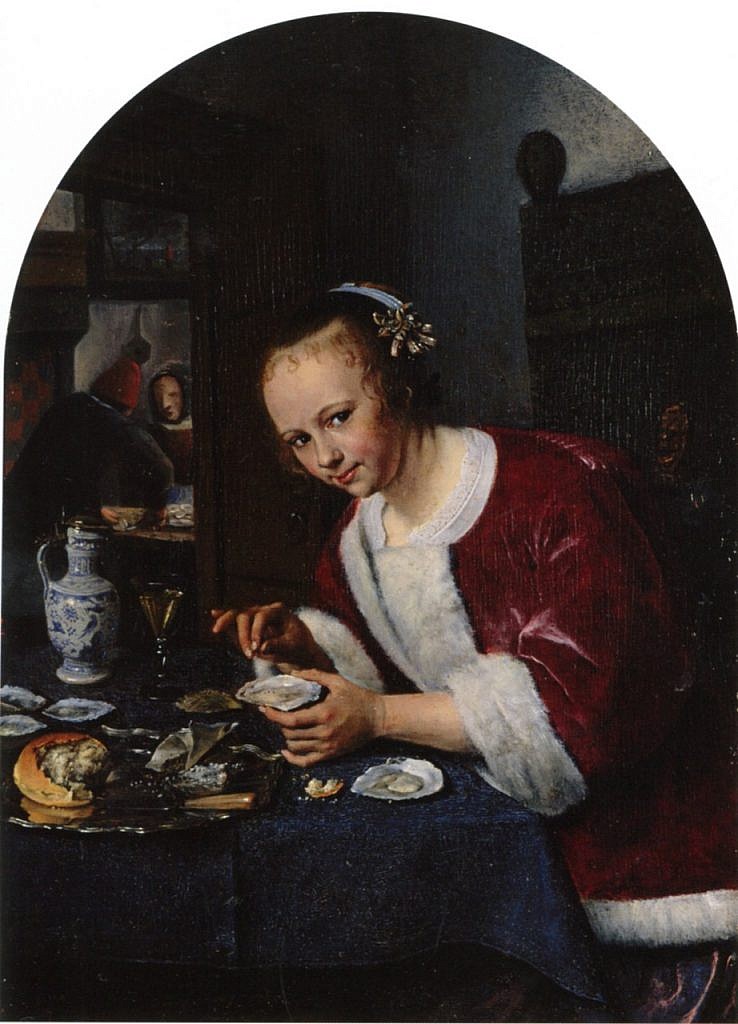
by Brooke Chilvers
Helen LaRose found me on Facebook, more than 40 years after we were teenagers on the loose together in Paris. Her name was different then, and I’m not sure I would have recognized her if we hadn’t arranged to meet in McCormick & Schmick’s with our no-longer-so-young husbands.
While breaking into our Blue Point and Chincoteague oysters, Helen broke out about the huge influence I’d had on her life for, apparently, not only had I introduced her to foreign films, starting with Visconti’s Death in Venice, I’d initiated her into the art of the raw oyster.
Paris was so cheap then! I think we paid 12 Francs for a half-dozen Fines de Claire oysters, served with a shallot mignonette sauce, thin slices of rye bread and delicious salted butter, with a ballon of Muscadet. In the days before the sterile, never-milky triploid oyster (due to its three sets of chromosomes), one really only ate oysters in months with “r’s.” So we probably ate ours at the first inklings of winter, when the brasserie outdoor stalls begin to overflow with selected pickings from the Bassin D’Arcachon in Aquitaine, the Marennes-d’Oléron oyster beds in Charente-Maritime, and Cancale on Brittany’s Emerald Coast.
How I started eating oysters, I (sadly) don’t recall; but I hope he was French and handsome.
Europe’s romance with oysters dates back 2,000 years, when the Romans set up icehouses along the entire 1,000-mile distance from England to Rome to keep the oyster carts moving. Emperor Vitellius is said to have eaten 1,200 in one sitting.
Interestingly, it was the seaside resorts of the 1920s, such as Deauville and Le Touquet, that gave us our ever popular plates of fresh raw oysters on the half-shell.
***
“Oysters in art” include two amusing 17th-century Dutch paintings in the Maurithuis in The Hague: “merry company” painter Jan Steen’s tiny masterpiece, The Oyster Eater (c. 1658-1660), and The Oyster Meal (1661) by Frans van Mieris, who studied under Rembrandt’s brilliant student Gerard Dou.

Both are full of erotic insinuations. Steen’s saucy-eyed protagonist is carefully salting the oysters as she looks straight out at the viewer. A draped bed lurks in the background. Mieris shows off the textured clothing of the lascivious older man and silk-white maiden whose innocence is on the line. She is already holding an oyster in one hand and a glass of wine in the other! And there’s another curtained bed!
***
Not far from La Rochelle are the Marenne-d’Oléron oysters of the Charente-Maritime region. These juicy Atlantic ocean tasting oysters come in four varieties, two of them “Label Rouge.” Spéciale de Claire, “finished” in clay ponds and not too fleshy, are a reliable favorite; but it was impossible to track down the “Cadillac” of oysters, the ivory-colored pousse en claire. Nobody in the region ignores Gillardeau oysters, for which Gérard Gillardeau was awarded La Légion d’honneur. Offered in many fine restaurants, I bought a bourriche of 24 from their fancy boutique on Ile d’Oléron and regretted having to share them.
In fact, Brittany boasts a dozen “grand crus” of huîtres creuses, from the Golfe of Morbihan to Cancale, where you can sit on the harbor’s concrete steps and eat 6-Euro plates of shucked oysters from the écaillers, chug your own chilled wine, and toss your shells.
Just down the road from the art-colony town of Pont-Aven in the Finistère département of Brittany that nurtured Gauguin is the quiet home of the rarer Belon flat oyster (huître plate), Riec-sur-Belon. More expensive, and charged by weight rather than by the dozen, Belon oysters are described as “finer” and less salty, due to their regular bathing in fresh water from two tidal rivers. I have friends who hate belons. Mine, bought directly from the producteur, were insistently muddy tasting. I’ll try them again, but in a restaurant.
Best of all is still my Sunday morning market oysterman selling his lovely sea-finished Cap de Fréhel oysters – from dainty little No. 4’s to his meaty No. 0’s for chopping. I don’t know his name, but he has won my heart this end of summer by counting out 14, instead of the traditional 13, for my weekly tryst with a dozen oysters.
______________________________________________________________________________
Brooke Chilvers married a handsome Frenchman from Brittany. But, hélas, he does not share her love of oysters.
